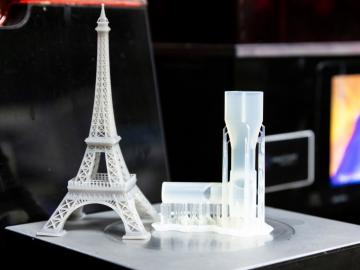
Filter News
Area of Research
- Biology and Environment (30)
- Clean Energy (28)
- Computer Science (1)
- Electricity and Smart Grid (1)
- Fuel Cycle Science and Technology (1)
- Fusion and Fission (14)
- Fusion Energy (3)
- Isotopes (10)
- Materials (31)
- National Security (17)
- Neutron Science (17)
- Nuclear Science and Technology (1)
- Supercomputing (44)
News Type
News Topics
- 3-D Printing/Advanced Manufacturing (6)
- Artificial Intelligence (14)
- Big Data (6)
- Bioenergy (9)
- Biology (16)
- Biomedical (3)
- Biotechnology (1)
- Buildings (6)
- Chemical Sciences (10)
- Clean Water (5)
- Climate Change (17)
- Composites (2)
- Computer Science (11)
- Coronavirus (1)
- Critical Materials (1)
- Cybersecurity (6)
- Decarbonization (17)
- Emergency (1)
- Energy Storage (7)
- Environment (28)
- Exascale Computing (11)
- Fossil Energy (2)
- Frontier (13)
- Fusion (7)
- Grid (10)
- High-Performance Computing (18)
- Hydropower (2)
- Isotopes (7)
- Machine Learning (10)
- Materials (21)
- Materials Science (7)
- Mathematics (2)
- Mercury (1)
- Microelectronics (2)
- Microscopy (3)
- Nanotechnology (4)
- National Security (15)
- Net Zero (3)
- Neutron Science (19)
- Nuclear Energy (14)
- Partnerships (6)
- Physics (10)
- Polymers (2)
- Quantum Computing (6)
- Quantum Science (3)
- Renewable Energy (1)
- Security (1)
- Simulation (19)
- Software (1)
- Space Exploration (4)
- Summit (7)
- Sustainable Energy (9)
- Transportation (4)
Media Contacts

Madhavi Martin brings a physicist’s tools and perspective to biological and environmental research at the Department of Energy’s Oak Ridge National Laboratory, supporting advances in bioenergy, soil carbon storage and environmental monitoring, and even helping solve a murder mystery.

Mike Huettel is a cyber technical professional. He also recently completed the 6-month Cyber Warfare Technician course for the United States Army, where he learned technical and tactical proficiency leadership in operations throughout the cyber domain.

Rose Montgomery, a distinguished researcher and leader of the Used Fuel and Nuclear Material Disposition group at ORNL, has been selected to participate in the U.S. WIN Nuclear Executives of Tomorrow, or NEXT, class of 2023 to 2024.

Autonomous labs are changing the nature of scientific investigation. Instead of humans manually orchestrating every part of an experiment, programmed equipment can carry out necessary functions. This workflow accelerates the pace of discovery by reducing the number of monotonous tasks that researchers must perform.

Researchers at the Department of Energy’s Oak Ridge National Laboratory are leading the way in understanding the effects of electrical faults in the modern U.S. power grid.

Nearly 100 interns were introduced to Oak Ridge National Laboratory’s biological and environmental research over the summer of 2023 as mentors and students were eager to share knowledge and skills to address the nation’s energy and environmental challenges.

Takaaki Koyanagi, an R&D staff member in the Materials Science and Technology Division of ORNL, has received the TMS Frontiers of Materials award.

A group at the Department of Energy's Oak Ridge National Laboratory made a difference for local youth through hands-on projects that connected neutron science and engineering intuitively.

Cody Lloyd became a nuclear engineer because of his interest in the Manhattan Project, the United States’ mission to advance nuclear science to end World War II. As a research associate in nuclear forensics at ORNL, Lloyd now teaches computers to interpret data from imagery of nuclear weapons tests from the 1950s and early 1960s, bringing his childhood fascination into his career

For more than half a century, the 1,000-foot-diameter spherical reflector dish at the Arecibo Observatory in Puerto Rico was the largest radio telescope in the world. Completed in 1963, the dish was built in a natural sinkhole, with the telescope’s feed antenna suspended 500 feet above the dish on a 1.8-million-pound steel platform. Three concrete towers and more than 4 miles of steel cables supported the platform.


